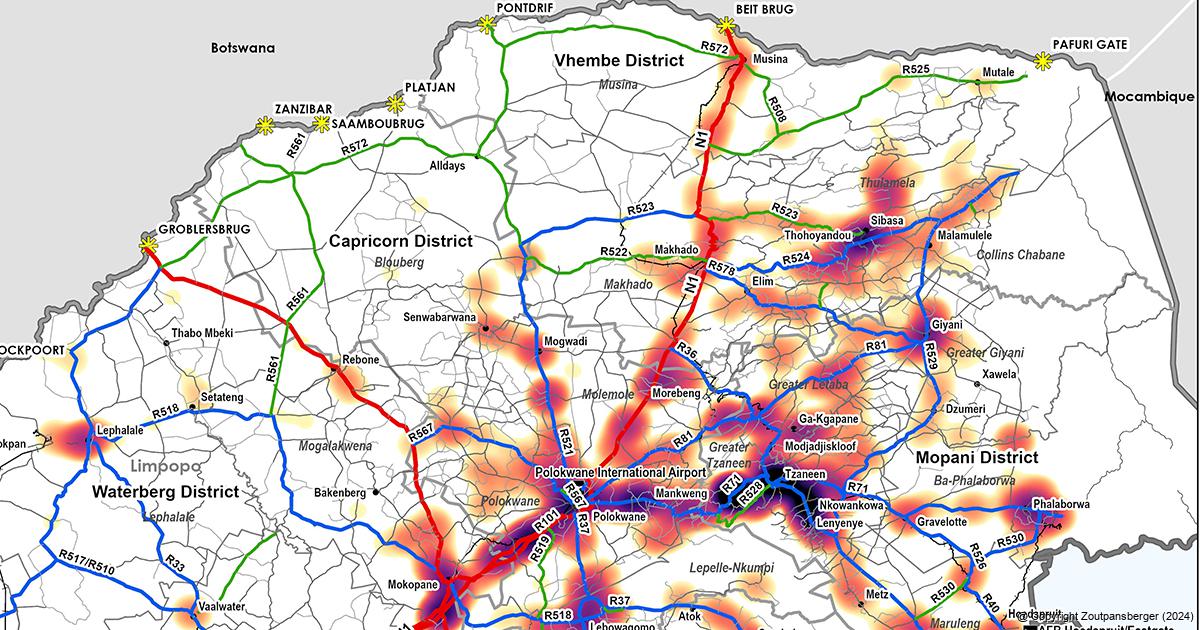

ADVERTISEMENT:

A map showing the accident hotspots in Limpopo Province.
Limpopo's traffic problems may require an African solution
Date: 22 June 2024 By: Anton van Zyl
Limpopo’s unacceptably high number of road fatalities may require a unique, locally designed solution that combines planning, enforcement and education. These were among the proposals made during a recent Limpopo Road Safety Programme (LRSP) Strategy Workshop held in Polokwane.
The workshop was organised by the Impact Catalyst, on behalf of the programme donor, the Anglo American Foundation. Sixty-seven delegates from a wide spectrum of stakeholder organisations, including the South African National Taxi Council (SANTACO), Road Traffic Infringement Agency (RTIA), Road Traffic Management Corporation (RTMC), the Road Agency Limpopo (RAL), and the South African Police Services (SAPS), attended the workshop. The initiative was also supported by several provincial government departments, agencies, and public organisations.
During the workshop, delegates were provided with a view of the current status in Limpopo and statistics highlighting which of the province’s roads were considered “very dangerous”. In the Vhembe area, the R578 leading from Elim towards Giyani is considered a “high-fatality road”. The R524, leading from Louis Trichardt to Thohoyandou, is also problematic, with a high fatality rate near Levubu and Sibasa. Other roads that claim many lives are the Mopani road (R525) and the road leading to Mudimeli.
As expected, much of the busy N1 is notorious for accidents. The Vhembe area with the highest incident rate is at Thohoyandou and Sibasa, with a ratio of more than 0.59 incidents per square kilometre.
Finding an African Solution
One proposal discussed at the workshop was to look at the problems holistically and address the underlying causes of many accidents. Roads such as the R578 and especially the R524, where it enters the Thohoyandou area, are highly congested with many pedestrian casualties. Often, this is due to a lack of spatial planning, where houses and businesses are right next to busy roads.
A proposal was put forth that traditional authorities be included in discussions and that these leaders be encouraged not to allow settlements to encroach on road reserves.
Many road fatalities in Limpopo, and indeed across South Africa, are caused by speeding, so greater emphasis must be placed on speed-calming measures such as speed humps and rumble strips.
Strategic Actions
During the workshop, the Limpopo Road Safety Strategy (LRSS) was discussed, with priorities divided into pre-2030 actions and post-2030 actions. High-impact pre-2030 actions proposed include implementing rest camps for trucks between towns and regulating the hours during which truck drivers are allowed on main roads (most notably the dangerous N1).
In Limpopo, many roads connecting towns and villages pass through densely populated areas with schools and clinics nearby. A high-impact proposal is that more pedestrian bridges be designed and constructed. Designated sidewalks for pedestrians, cyclists, and people with disabilities should also be considered. For cyclists, the suggestion was that legislation be adopted to make the wearing of visible clothing and protective gear compulsory – something that would require adoption and enforcement across the province.
Addressing Corruption
Although corruption among law enforcers and licensing officials was not dealt with as a separate matter, it featured prominently during the workshop. One of the objectives of the National Road Safety Strategy (NRSS) – the South African national strategy - is to eliminate instances of fraud and corruption through improved anti-corruption processes and enforcement. A high-priority action is to enforce monitoring of vehicle-testing centres.
Another proposal was that roadworthiness testing be done every five years for new vehicles, and then annually thereafter. Because behaviour contributes to more than 80% of fatalities and accidents, investing in more speed cameras and increasing the visibility of traffic officials are necessary – something that the Limpopo Province has been focusing on as part of their strategy.
Training and Enforcement
Ongoing training for law enforcement officers and prosecutors was highlighted as crucial. Penalties for offenders, such as fines, should be reviewed and potentially increased.
According to Ms Carole Mitzi, a member of the LRSP project team, the Limpopo Province has several existing policy documents, frameworks, and programmes addressing road safety. A common thread in these initiatives is the importance of clear planning, coherent systems, and an improved crash-data-reporting system. Key challenges identified in Limpopo include the overloading of heavy vehicles, conducting road safety campaigns, maintaining roads, and investing in automated traffic controls.
"The high-priority interventions identified outline what needs to be tackled before 2030 and also help streamline the road-safety strategy for the Limpopo Province. Once finalised, we hope to inculcate behaviour and attitude changes towards road safety among community members and school learners. The long-term goal is to reduce injuries and fatalities," emphasised LRSP Programme Manager Dr Jonathan James.
Viewed: 2307
|
|
Tweet |

-

Nel skuldig aan aanranding met die doel om ernstig te beseer
28 June 2024 By Andries van Zyl -

Moenie val vir hierdie 'munisipale' betalingslenter nie
28 June 2024 By Andries van Zyl -

Annekie se dood laat groot leemte in gemeenskap
28 June 2024 By Pétria de Vaal -

Killers net te sterk vir Vikings in finaal van T10-liga
28 June 2024 By Andries van Zyl -

'Waterless' Vhembe causes problems for Phelophepa Health Train
27 June 2024 By Thembi Siaga

Anton van Zyl
Anton van Zyl has been with the Zoutpansberger and Limpopo Mirror since 1990. He graduated from the Rand Afrikaans University (now University of Johannesburg) and obtained a BA Communications degree. He is a founder member of the Association of Independent Publishers.

More photos...

ADVERTISEMENT


-

Where do Limpopo's residents move to?
16 June 2024 By Anton van Zyl -

No, the “foreigners” are not suffocating us in Vhembe.
16 June 2024 By Anton van Zyl -

'Lady doctor' from Mashamba Limpopo's first female premier
21 June 2024 By Elmon Tshikhudo -

ANC struggled nationally, but dominant in Vhembe
06 June 2024 By Anton van Zyl -

Limpopo's traffic problems may require an African solution
22 June 2024 By Anton van Zyl

ADVERTISEMENT:


ADVERTISEMENT


